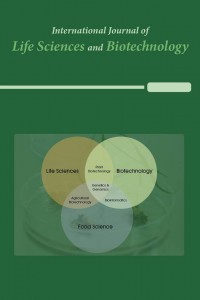Laktik Asit Bakterilerinin (LAB) ve Pangasius Nasutus'tan İlgili Bir Patojenik Suşun Birlikte İzolasyonu
Pangasius nasutus, Lactococcus lactis, lactococcus garvieae, aquaculture probiotic
The Co-Isolation of Lactic Acid Bacteria (LAB) and A Related Pathogenic Strain from Pangasius Nasutus
___
- 1. Chiew, M.K.I., A.M. Salter, and Y.Z. Yin Sze Lim, The significance of major viral and bacterial diseases in Malaysian aquaculture industry. Pertanika Journal of Tropical Agricultural Science, 2019. 42(3): p. 1023-1047.
- 2. Alagesh, T., 'Ikan patin' at risk of becoming endangered. , in New Straits Time. 2017, NST Press (M) Sdn, Bhd.
- 3. Preena, P.G., et al., Antimicrobial resistance in aquaculture: a crisis for concern. Biologia, 2020. 75(9): p. 1497-1517.
- 4. Ee Lean, T., et al., Antibiotic residues from aquaculture farms and their ecological risks in Southeast Asia: a case study from Malaysia. Ecosystem Health and Sustainability, 2021. 7(1): p. 1926337.
- 5. Wang, C., et al., Beneficial bacteria for aquaculture: nutrition, bacteriostasis and immunoregulation. J Appl Microbiol, 2020. 128(1): p. 28-40.
- 6. Anjana and S. Tiwari, Bacteriocin-Producing Probiotic Lactic Acid Bacteria in Controlling Dysbiosis of the Gut Microbiota. Frontiers in Cellular and Infection Microbiology, 2022. 12.
- 7. Hien Van, D., et al., Host-Associated Probiotics: A Key Factor in Sustainable Aquaculture. Reviews in Fisheries Science & Aquaculture, 2019. 28(1): p. 16-42.
- 8. Pereira, W.A., et al., Bacteriocinogenic probiotic bacteria isolated from an aquatic environment inhibit the growth of food and fish pathogens. Scientific Reports, 2022. 12(1): p. 5530.
- 9. Goa, T., et al., Isolation and Characterization of Lactic Acid Bacteria from Fermented Milk Produced in Jimma Town, Southwest Ethiopia, and Evaluation of their Antimicrobial Activity against Selected Pathogenic Bacteria. Int J Food Sci, 2022. 2022: p. 2076021.
- 10. Wambui, J., P. Lamuka, and P. Njage, Lactic acid bacteria isolates from fermented camel milk (suusac) are potential protective cultures of raw camel meat. International Journal of Agriculture and Environmental Research, 2017. 3: p. 2960-2975.
- 11. Sandra, T.-S., et al., In vitro evaluation of the antimicrobial activity of a range of probiotics against pathogens: Evidence for the effects of organic acids. Anaerobe, 2012. 18(5): p. 530-538.
- 12. Diop, M.B., et al., Bacteriocin producers from traditional food products. Biotechnologie, Agronomie, Société et Environnement, 2007. 11(4): p. 275.
- 13. Hamid, T.T.A.H. and N.F.A.M. Fuzi, Lactic acid bacterium with antimicrobial properties from selected malay traditional fermented foods. International Journal of Life Sciences and Biotechnology, 2021. 4(1-2): p. 11-34.
- 14. Lemoine, F., Correia, D., Lefort, V., Doppelt-Azeroual, O., Mareuil, F., Cohen-Boulakia, S. , & Gascuel, O., NGPhylogeny.fr: new generation phylogenetic services for non-specialists. Nucleic Acids Research, 47(W1), W260-W265. Nucleic Acids Research, , 2019. 47(W1): p. W260-W265.
- 15. Pulipati, S., et al., Fermented veggies: antibacterial efficacy of isolated lactic acid bacteria. World Journal of Pharmacy and Pharmaceutical Sciences, 2019. 8(9): p. 270-283.
- 16. Haro, G., I. Iksen, and N. Nasri, Identification, characterization and antibacterial potential of probiotic lactic acid bacteria isolated from Naniura (a traditional batak fermented food from Carp) against Salmonella typhi. Rasayan Journal of Chemistry, 2020. 13: p. 464-468.
- 17. Suzuki, A. and M. Suzuki, Antimicrobial Activity of Lactococcus lactis subsp. lactis Isolated from a Stranded Cuvier’s Beaked Whale (Ziphius cavirostris) against Gram-Positive and -Negative Bacteria. . Microorganisms, 2021. 9(2): p. 243.
- 18. Itoi, S., et al., Isolation of halotolerant Lactococcus lactis subsp. lactis from intestinal tract of coastal fish. Int J Food Microbiol, 2008. 121(1): p. 116-21.
- 19. Itoi, S., et al., The clam Meretrix lamarckii (Bivalvia: Veneridae) is a rich repository of marine lactic acid bacterial strains. Annals of Microbiology, 2014. 64(3): p. 1267-1274.
- 20. Cadirci, B. and S. Citak, Antagonistic Effects of Some Lactobacilli On Some Gram-Negative Bacteria. Gazi Univ J Sci, 2010. 23.
- 21. Noraphat, H., et al., Inhibition of food-spoilage and foodborne pathogenic bacteria by a nisin Z-producing Lactococcus lactis subsp. lactis KT2W2L. LWT - Food Science and Technology, 2017. 82: p. 170-175.
- 22. Hamid, T.A.T.H., I. Khairil, and A. Mohammed, Lactococcus Lactis Strains from Intestinal Organ of Black Tips Shark Carcharhinus Limbatus Producing Nisin-Like Bacteriocin Active against Shrimp and Fish Pathogens (Vibrio Parahaemolyticus and Vibrio Alginolyticus). Journal of Microbiology, Biotechnology & Food Science, 2020. 10(3).
- 23. Van Doan, H., et al., Host-associated probiotics boosted mucosal and serum immunity, disease resistance and growth performance of Nile tilapia (Oreochromis niloticus). Aquaculture, 2018. 491: p. 94-100.
- 24. Meyburgh, C.M., R.R. Bragg, and C.E. Boucher, Lactococcus garvieae: an emerging bacterial pathogen of fish. Dis Aquat Organ, 2017. 123(1): p. 67-79.
- 25. Malek Alexandre, et al., Lactococcus garvieae, an unusual pathogen in infective endocarditis: case report and review of the literature. BMC Infectious Diseases, 2019. 19(1): p. 301.
- 26. Varsha, K.K. and K.M. Nampoothiri, Lactococcus garvieae subsp. bovis subsp. nov., lactic acid bacteria isolated from wild gaur (Bos gaurus) dung, and description of Lactococcus garvieae subsp. garvieae subsp. nov. Int J Syst Evol Microbiol, 2016. 66(10): p. 3805-3809.
- 27. Vendrell, D., Balcázar, J. L., Ruiz-Zarzuela, I., de Blas, I., Gironés, O., & Múzquiz, J. L., Lactococcus garvieae in fish: a review. Comparative immunology, microbiology and infectious diseases,. 2006. 29(4): p. 177–198.
- 28. Soltani, M., et al., Lactococcosis a re-Emerging disease in aquaculture: disease significant and phytotherapy. Vet Sci, 2021. 8(9).
- 29. Ismail, S., M.S. Kamarudin, and E. Ramezani-Fard, Performance of Commercial Poultry Offal Meal as Fishmeal Replacement in the Diet of Juvenile Malaysian Mahseer, Tor tambroides. Asian Journal of Animal and Veterinary Advances, 2013. 8: p. 284-292.
- Yayın Aralığı: Yılda 3 Sayı
- Başlangıç: 2018
- Yayıncı: International Society of Academicians
Muhammed YÜCEER, Cemre ÇELİKTEN, Rukiye MAVUŞ, Ebubekir DİŞLİ, Şeyma AĞIRAL AKGÜN, Emre SARI
Nur Hannah Rashıdah HAJA MOHIDEEN, Nurul Sakinah ALİAS, Nur Nazifah MANSUR, Tengku Haziyamin TENGKU ABDUL HAMİD
Enes Gökhan YILMAZ, Kezban DİNÇ, İskender TİRYAKİ
Şanlıurfa'da (Türkiye) Bazı Yabani Kuşların Filogenetik Analizi
Arif PARMAKSIZ, Adil UZTEMUR, Cahit ÇEÇEN
Doronicum Cinsinin Taksonomisi, Geleneksel Kullanımı ve Terapötik Önemi: Derleme
Zeynep Büşra ERARSLAN, Şükran KÜLTÜR
Lahanagil Sebze Türlerinin Kök Sistemi Mimarileri Yönünden Karşılaştırılması
